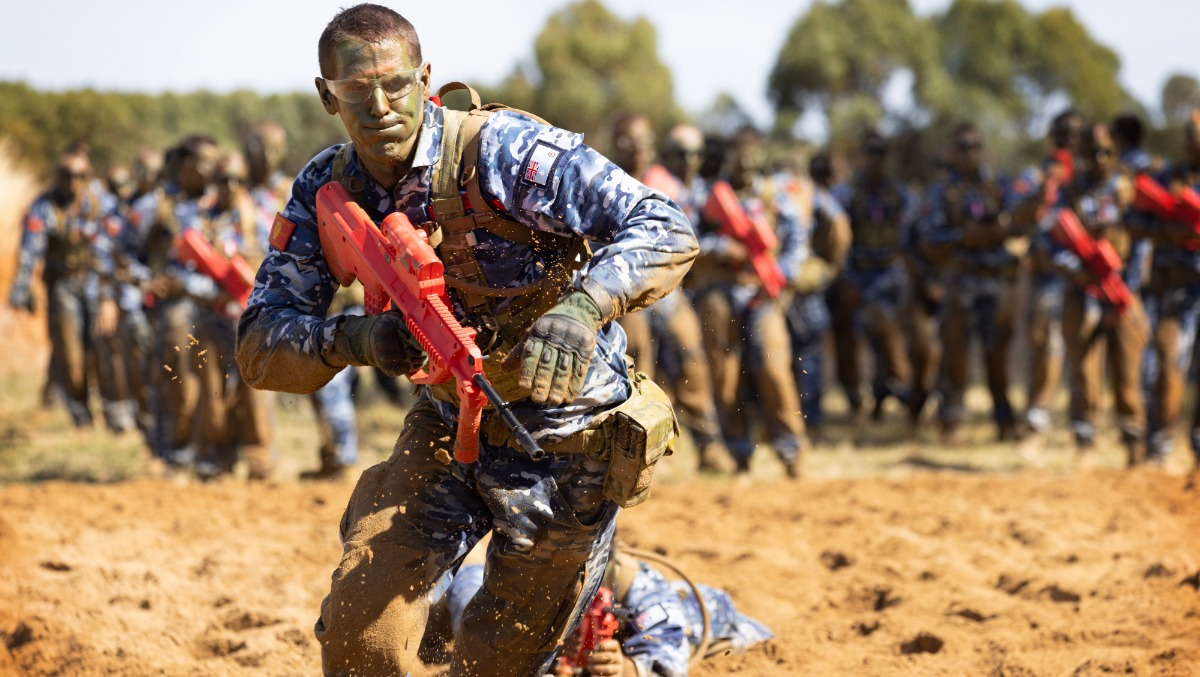
The RAAF has begun streamlining recruit training under a “less is more” approach to graduate trainees quicker and more efficiently.
Under the new system, 1 Recruit Training Unit (1RTU) – which is responsible for two-thirds of the Air Force’s initial preparation – will reduce from 11 weeks to nine, and its training block will be tightened.
RAAF Officer Training School, which conducts the bulk of the remaining training, will see a more significant reduction from 17 to 12 weeks.
Officer trainees are temporarily issued Australian multi-cam camouflage uniforms to instil a warfighter attitude during their field phase.
The shortened course means 1RTU can run additional sessions during the year with less overlap, resulting in an increased 1RTU capacity by 85 per cent compared to the number of recruits trained in 2022.
Airfield Defence Guard Corporal Ricky Watson said compression of the course allowed the ground defence element to have more time with trainees instead of splitting their time into different blocks.
“We wasted time signing weapons in and out and going through revision of topics we covered in prior weeks,” CPL Watson said.
“Now it’s weapons, range, chemical, biological, radiological and nuclear (CBRN) and ground defence. We’re able to get a lot more out of it knowing we don’t have to revisit things later on course, and they are more focused.”
CPL Watson said this year’s introduction of range practices is improving their skills in combat shooting.
A combat marksmanship continuum has been included to give aviators a better understanding of operating in difficult environments.
Recruits also undertake tasks such as defending an imitation air base, tackling a confidence course of climbing ropes, mounted walls and tunnels, as well as being introduced to the new EF88 carbine firearm.
Executive Officer 1RTU Squadron Leader Matt Kelly said the new training approach removes inefficiency while consolidating blue and green phases.
“We introduce them to the fundamentals and gradually increase the tempo to the point where they have the skills they need to enter our workforce,” SQNLDR Kelly said.
“We’re now thinking very clearly about what training outcomes Air Force needs in preparing for operations in our region and are designing a product to align with that.”
Recruitment is a reoccurring issue across ADF, APS, and defence industry which will continue to deteriorate without creative and flexible responses, according to the Defence Strategic Review released on 24 April.
That document recommended an increase in recruitment speed from application-to-enlistment-to-recruitment and the process of recruitment should be achieved in days, not months.
Commanding Officer OTS Wing Commander Garth Herriot said the training content has been refined and distilled.
“We have cut out the bits of fat within the program. The learning outcomes that we deliver largely remain the same and if not, we have modified them to meet contemporary requirements,” WGCDR Herriot said.
“We used to hop on a bus and drive for a few hours for adventure training, whereas now we now have a brand-new abseiling tower on site.”
There is always going to be risk with such changes, but it is about accepting that risk and training to deliver an outcome, according to the Commanding Officer.
“We might have to do less physical training, but we are able to graduate someone faster for Air Force,” WGCDR Herriot said.
“We identified training duplication within the course and removed the inefficiencies, but we are still graduating our trainees at a high level.”
An isometric mid-thigh pull has been introduced to measure the strength and power of incoming recruits and a fixed barbell deadlift with force plate has been introduced to test immediate peak force generated. Results are instantaneous and recorded on a digital profile for future comparison.
Accelerometers have been introduced to balance load during drill lessons, and an app has been added to track mental health fitness.
Civilian physiotherapists have integrated to minimise recruits’ time in medical, and a “shoes to boots” program has been devised to acclimate recruits to new footwear and mitigate injuries.
A high rate of musculoskeletal injury from recruits walking up to 10km a day had previously been identified in a 2021 survey.
Physical training instructor Corporal Mark Theron sees only positive changes in the recent overhaul of the physical component at 1RTU.
“The goalposts are always shifting. Towards the end of 2021, the baseline marker was always just physical fitness test passing,” CPL Theron said.
“That’s still one of our main objectives, but we’re trying to instil longevity in our recruits.
“As opposed to getting them really good at push-ups and sit-ups, we are actually teaching them basic movement methods that they can take on operations and through their whole career.
“Previously, if someone presented to us with an injury, we’d send them to medical and you would lose them for that session.
“There are always going to be injuries outfield, some preventable and some not — that’s the nature of the beast.
“We are trying to make everyone better through individualisation.”















